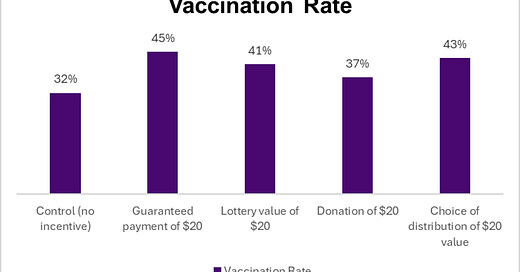Source: Campos-Mercae, et al NBER September, 2024
Employers have many health-related incentive programs in place. The 2024 Best Practices in Healthcare Survey from WTW shows that 47% of employers offer some type of incentive for lifestyle, and 38% have smoker penalties. Incentive programs, however, don’t always work as intended. Employees generally fail to earn over half the available incentive dollars. Some incentive programs designed years ago might no longer follow best available evidence. And many incentive programs are expensive to operate and difficult to communicate.
There were many incentive programs to increase vaccination uptake during the pandemic, and a new preprint of research from Sweden reviewed the results of a carefully designed program that worked well. The researchers randomized a group of 5,324 people in 2022 just as the first booster dose of COVID-19 vaccine became available. A control group received no incentives but were encouraged to get vaccinated, and four incentive groups were promised one of four incentives when they were vaccinated:
(1) a $20 payment,
(2) a lottery with expected value of $20,
(3) a $20 donation to charity, or
(4) an ability to choose among these three options.
The researchers used population-wide immunization registries to verify vaccination and tax data to identify family members of those in the study.
A plurality of those given the choice chose the guaranteed payment, as shown below:
The researchers continued to monitor the participants, and all but the donation incentive group were statistically significantly more likely to get subsequent COVID-19 boosters as they became available, even though they were offered no further incentive. This addresses a concern that an incentive might make someone less likely to take a desired action once the incentive is withdrawn. Family members of those in each of the incentive groups were 6-8% more likely to be vaccinated than family members in the control group.
Implications for employers:
- This carefully designed study suggests that a simple payment can significantly increase vaccination rate. We must be cautious, though, to extrapolate results in Sweden during the pandemic to other geographies absent the threat of the pandemic.
- The simplest incentive, a guaranteed payment, performed better than more complicated incentives.
- Employers that deploy incentive programs should update them to keep them consistent with current recommendations. For instance, providing incentives for certain preventive services at more frequent intervals than they are recommended can encourage unnecessary care and raise medical costs.
- Employers that deploy incentive programs should review results and be sure that the incentive programs are achieving their objectives without excessive administrative expense. Well-designed incentive programs should also not lead to employee dissatisfaction.
- This shows that a simple reminder to get vaccinated improves vaccination rates, and highlights the importance of social networks in promoting desirable health actions.
Thanks for reading! Hope you’ll subscribe to this newsletter, and please hit the "like" button. Please also recommend to friends and colleagues - it's free. You can find previous posts at this link.
Thursday: Shorts, including mental health parity regs, RSV vaccination, race based algorithms and Body Roundness Index




